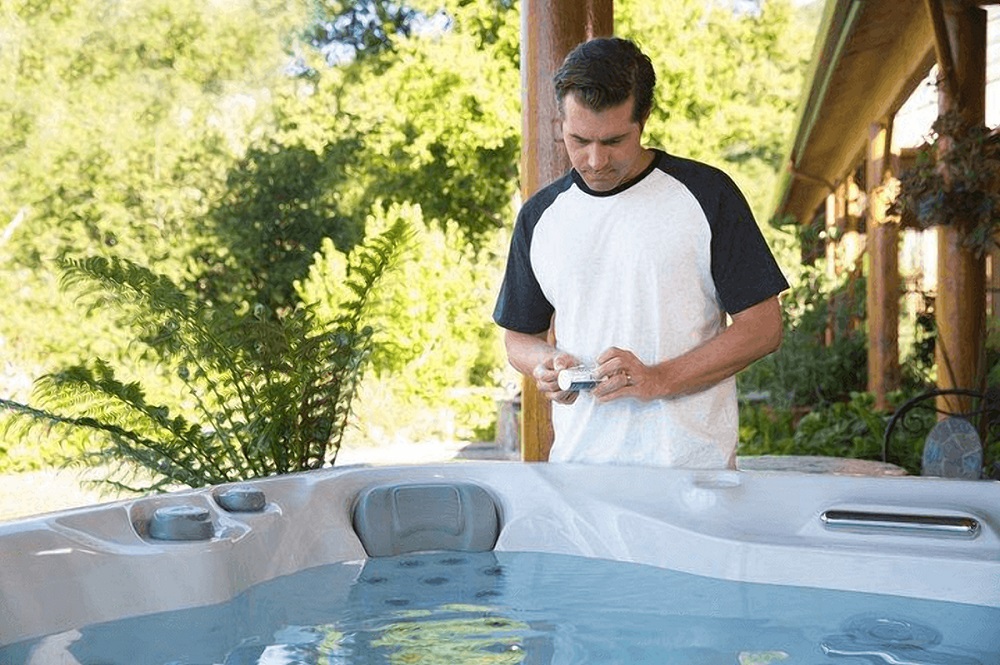Keeping your spa clean and safe is an important task. In this article, we will explore the key differences between chlorine and bromine, their effectiveness as sanitizers, their impact on the water and air, and the factors to consider when choosing between them for your pool or spa. You should know both are effective, but have differ in their properties and performance that make them more suitable in certain circumstances.
We’ll also highlight the potential risks and benefits of using these chemicals and provide tips on safety and effectiveness.
Also, don’t forget that sanitizers are not the only thing to have in your kit. So pay attention to what are the must-have chemicals for your hot tub!
Bromine Vs Chlorine: What Are They And How Do They Work
Bromine and chlorine are common chemical sanitizers used in hot tubs or pools to kill bacteria and other harmful microorganisms in the water. We want to explain how both of them work, so you can see the initial difference.
Bromine
Organic pollutants are not an obstacle for bromine, because it ionizes them. The task of the ions is to break the bonds of the pollutants, because this kills them. After everything is done, we meet bromamines – a by-product of its activity. We mention them only because they reduce the sanitizer’s effectiveness. However, weekly shocking your hot tub is the ideal solution here.
Chlorine
In comparison to bromine, chlorine oxidizes, kills, and stops the reproduction of pollutants, which can cause build-ups in hot tub water and create a breeding ground for harmful microorganisms. Chlorine (like bromine) turns into a chloramine waste product. The chlorine odor, which can also make your eyes burn, comes from this.
Unfortunately, chloramines also have the negative property of reducing the effectiveness of sanitizers. In this case, you only need to add chlorine weekly to maintain this “chloramine war”.
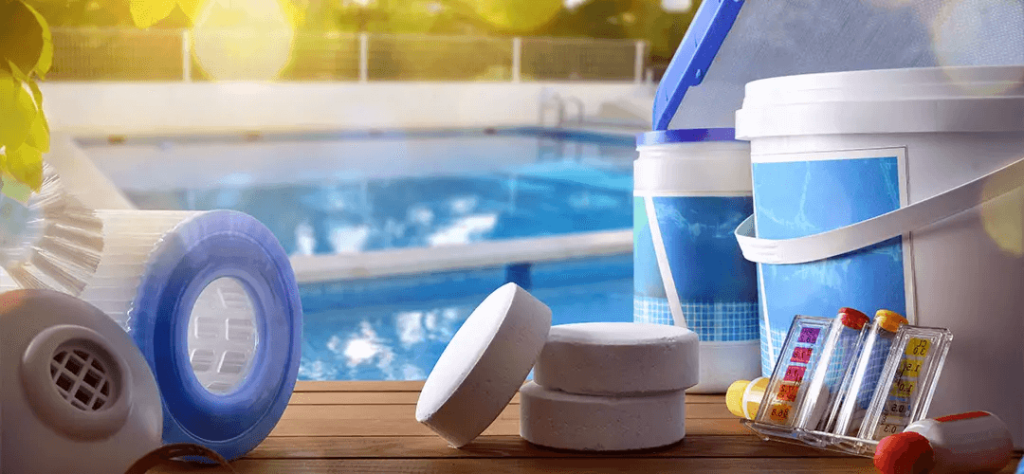
What’s The Difference Between Bromine And Chlorine?
Since you now understand how chlorine and bromine work, it is important that we outline all of their distinctions for you to be able to determine which one is the best for your scenario. Let’s dive in!
Performance
Although both do their job effectively, under certain circumstances you will find one of the two options to be the better one. For example, chlorine eliminates viruses at a phenomenal rate, while bromine is better at preventing algae growth. In addition, bromine is your friend at keeping your water well-balanced as it has lower pH.
Stability
Bromine is more stable than chlorine in hot water environments, making it a superior choice for spas and hot tubs. Chlorine can dissipate quickly in hot water, which can make it less effective at controlling bacteria and other microorganisms. However, bromine can be rapidly destroyed by ultraviolet light (Spa hack: to break the rules, you’ll need to cover your hot tub).
Smell
Chlorine has a distinct, strong odor that is often described as harsh, pungent, or even bleach-like. Compared to chlorine, however, bromine has a softer, less overpowering smell.
Frequency And Quantity Of Use
The frequency and quantity of bromine and chlorine usage will depend on several factors, including the size of the spa and its volume. But both chemicals should be added to the hot tub water regularly to ensure that the water remains safe and healthy.
Generally, by adding a small amount of bromine or chlorine to the water after each use, you make your hot tub maximum safe (you can check the table below for concrete figures). Also, you can shock your spa water once a week (or as necessary) with a higher dose of chlorine or bromine to maintain proper levels.
| Chlorine | Bromine | |
| The recommended dosage | ≈ 3 grams for 265 gallons (1000 l) | ≈ 5 grams (or 1 tsp) for 265 gallons (1000 l) |
But as the chlorine dissipates quicker, you may add it more frequently than bromine. Remember that regular testing of the water in your spa is crucial to ensure that the concentration of chlorine or bromine is at the appropriate level. This allows you to adjust the needed dosage to maintain proper levels.
Cost
It’s important to pay attention to the long-term cost so that your choice is the most beneficial. Although the price of bromine may be higher, bromine works more slowly (and therefore longer) and doesn’t need to be replenished frequently. In the end, the cost of bromine and chlorine may balance out.
We’d like to sum everything described up in a verdict table for easier understanding.
| Situation/Answer | Yes | No |
| Are you choosing a chemical for the spa? | Bromine (as it is more stable in hot water environments) | Chlorine |
| Do you have an outdoor hot tub/pool? | Chlorine (especially if it is under sunlight) | Bromine (can be used outside, but with a spa/pool cover) |
| Does smell play a big role? | Bromine | Chlorine |
| Do you want to spend less time doing chemistry maintenance? | Bromine | Chlorine |
| Is the price important to you? | Chlorine | Bromine |
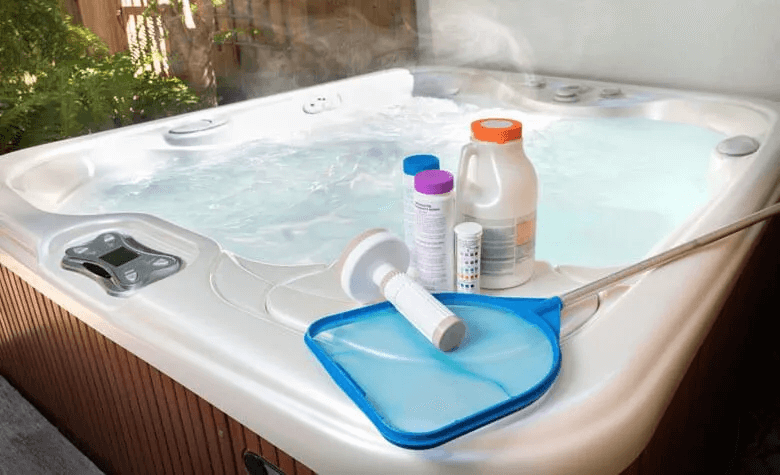
Which Is Safer For The Skin: Chlorine Or Bromine?
You should always have a responsible approach when it comes to health. So let’s discover what is the most skin-friendly chemical and why.
After much discussion and analysis, bromine is considered the safer option. This is because bromine is less likely to cause skin irritation, dryness, or itching. In addition, bromine doesn’t provoke allergic reactions as chlorine does.
Chlorine can cause skin irritation, especially in high concentrations or when the pH level of the spa water is not properly balanced. It can also dry out the skin, hair, and nails, leading to itching and flakiness.
Good news! Even if you use a lot of bromine, it’s very unlikely to cause irritation to your skin..
If you have sensitive skin or are prone to skin irritation or allergic reactions, bromine may be a better choice than chlorine. However, it is important to maintain the proper amount of sanitizer and test the spa water regularly to ensure it remains safe and healthy for use.
Friendship: Can I Use Bromine And Chlorine Together?
You may be curious about using bromine and chlorine together or alternating them due to certain circumstances. And as this is a logical question, we decided to give you an exhaustive answer.
As you definitely don’t want to be a victim of a hazardous chemical reaction, don’t mix chlorine and bromine in your spa or in their dry form. Also, it’s dangerous to use the same feeder for different tablets. Even if you have cleaned it thoroughly, it may be that some particles have remained, so as a result, when you add another tablet they can react. You can get eye and skin irritation, respiratory problems, and other health issues as a mixing consequence.
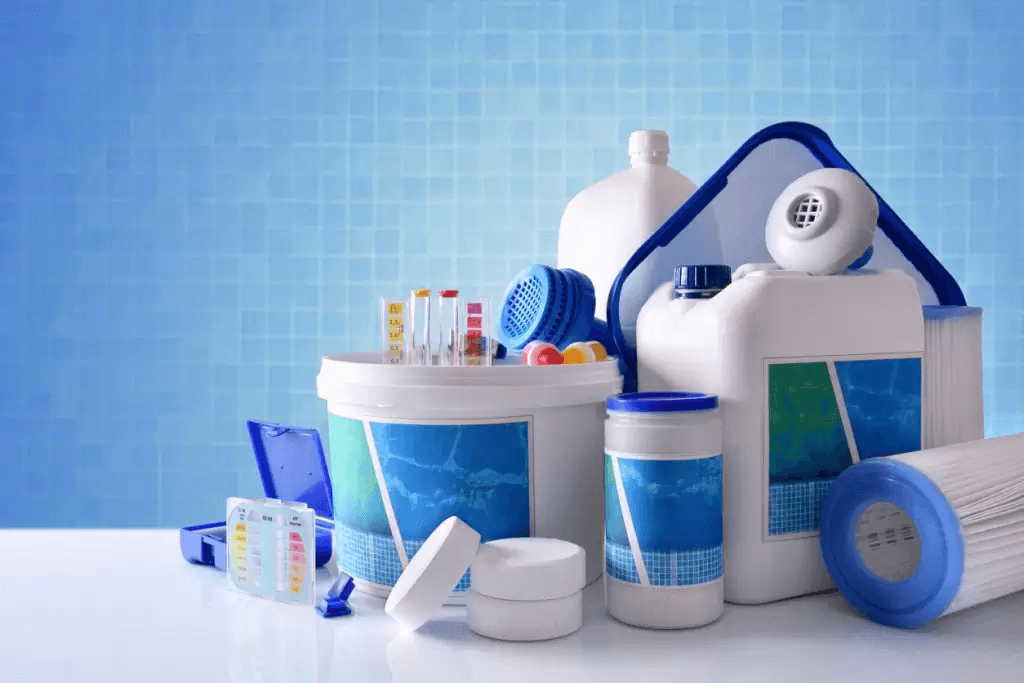
Is It Possible To Switch From One To Another?
Perhaps you’re still not sure about the choice of a particular chemical, so trying both of them can be the only way to find your perfect match. But is it even possible?
Luckily, yes, it’s possible, but you should know the right steps to take not to harm yourself and your hot tub. Surely, we won’t leave you alone with this task, so we have prepared easy-to-follow instructions to make this process smooth and avoid any unwanted reactions.
- Fully drain and clean your hot tub. This will remove any residual contaminants that could react with the new chemical.
- Do a line flush. As there also can be remaining contaminants that can combine with a new chemical and have unpleasant consequences, it’s a necessary step.
- Fill your spa with fresh water when the cleaning process is over.
- Test and add sanitizer. After filling up your hot tub, it’s important to test the pH level of the water before adding any chemicals. Once you know the pH level, you can then determine the appropriate amount of chemicals needed to balance the water.
- Monitor and maintain the right chemical levels to ensure your safety.
Bromine and Chlorine: Tablets or Granules for Maximum Efficiency
Now, if you are searching for sanitizer, it usually comes in two forms: tablets and granules. So let us provide you with their differences and use peculiarities to make your choice as simple as possible.
Bromine vs Chlorine: Granules Edition
The process of using chlorine and bromine granules is similar, but there are some differences in the application and dosage.
- Measuring your hot tub volume. As for bromine, the recommended range for the chemical concentration in the spa water is typically between 3 and 5 parts per million (ppm), while for chlorine that level is between 1 and 3 ppm. You should know how many liters/gallons are in your hot tub (or pool) to calculate the right chemical portion.
- Adding process. When you know the amount of water your spa can hold, you should carefully read the chemical instructions as it tells the recommended dosage. Once you have discovered the right chemical quantity, you will turn on your hot tub, pour the chemicals directly into the water, and let it circulate for at least 20 minutes.
- Testing. The final step is to check the chemical levels of your spa to define your next moves.
Bromine vs Chlorine: Tablets Edition
The great news is that you don’t need to add tablets as often as granules. And as with granules, the process for bromine and chlorine is similar.
- Instructions. First, you should read the chemical instructions, as it tells the right amount of tablets to add (depending on the size of your hot tub) and the recommended flow rate for the best chemical dispensing.
- Adding process. Find the right amount of tablets you should add to a floater (or so-called feeder) according to the manufacturer’s instructions.
- Test. As tablets act for a longer period, we suggest checking your chemical levels for a couple of next days. When they are above normal, it’s time to replace them. But if the chemical levels are too low, the best decision is to add one more tablet.
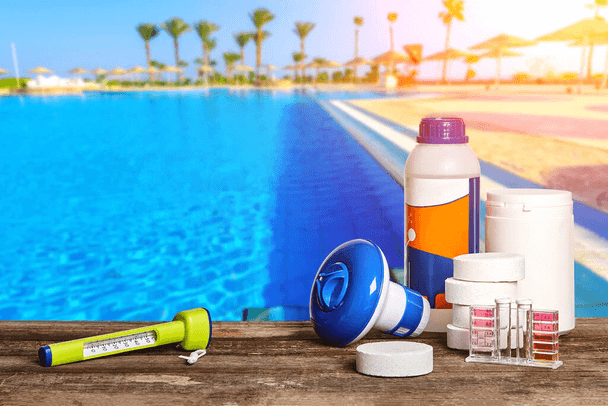
Conclusion
We hope you get the answers to all your troubling questions. Choosing the right sanitizer for your hot tub involves considering several factors, including your personal preferences, specific requirements, and unique circumstances. It’s important to consider things like the frequency of use, budget, and maintenance requirements before selecting a sanitizer.
However, we recommend using bromine in the following situations:
- You have a covered (or indoor) hot tub, or it’s not under sunlight;
- Your skin, eyes, and nose are too sensitive to chlorine;
- You don’t want to add sanitizer too often.
In the opposite cases, chlorine may be a better choice.
Either way, the choice between these two is safe as they’ll not leave a trace of bacteria in your spa!
FAQ
🔬 Why Is Bromine Better Than Chlorine?
Bromine can be definitely better if you have sensitive skin, don’t want to relax in smelling water, have your spa indoors, or if it is covered. Also, you don’t need to add bromine as frequently as chlorine.
💭 Can I Switch From Chlorine to Bromine?
Yes, you can switch from chlorine to bromine in your spa, but it is important to follow some basic guidelines to ensure a smooth transition and maintain proper water quality.
📈 Is It Better to Use Bromine or Chlorine?
Whether it is better to use bromine or chlorine in your spa depends on your personal preferences, water quality, and maintenance requirements. Both chemical sanitizers are effective at maintaining your spa, but they differ in their properties and performance.
🥼 Is Bromine More Toxic Than Chlorine?
In general, bromine is considered less toxic than chlorine. Nevertheless, it is important to follow the manufacturer’s instructions when using bromine and to take proper safety precautions when handling and storing the chemical.


